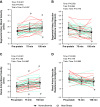Glomerular filtration rate reserve is reduced during mild passive heat stress in healthy young adults
- PMID: 35816723
- PMCID: PMC9423723
- DOI: 10.1152/ajpregu.00090.2022
Glomerular filtration rate reserve is reduced during mild passive heat stress in healthy young adults
Abstract
We tested the hypothesis that, compared with normothermia, the increase in glomerular filtration rate (GFR) after an oral protein load (defined as the GFR reserve) is attenuated during moderate passive heat stress in young healthy adults. Sixteen participants (5 women; 26 ± 2 yr) completed two experimental visits, heat stress or a normothermic time-control, assigned in a block-randomized crossover design. During the heat stress trial, core temperature was increased by 0.6°C in the first hour before commencing a 2-min cold pressor test (CPT) to assess renal vasoconstrictor responses. One-hour post-CPT, subjects ingested a whey protein shake (1.2 g of protein/kg body wt), and measurements were taken pre-, 75, and 150 min postprotein. Segmental artery vascular resistance was calculated as the quotient of Doppler ultrasound-derived segmental artery blood velocity and mean arterial pressure and provided an estimate of renal vascular tone. GFR was estimated from creatinine clearance. The increase in segmental artery vascular resistance during the CPT was attenuated during heat stress (end CPT: 5.6 ± 0.9 vs. 4.7 ± 1.1 mmHg/cm/s, P = 0.024). However, the reduction in segmental artery vascular resistance in response to an oral protein load did not differ between heat stress (at 150 min: 1.9 ± 0.4 mmHg/cm/s) and normothermia (at 150 min: 1.8 ± 0.5 mmHg/cm/s; P = 0.979). The peak increase in creatinine clearance postprotein, independent of time, was attenuated during heat stress (+26 ± 19 vs. +16 ± 20 mL/min, P = 0.013, n = 13). GFR reserve is diminished by mild passive heat stress. Moreover, renal vasoconstrictor responses are attenuated by mild passive heat stress, but renal vasodilator responses are maintained.
Keywords: glomerular filtration rate; heat stress; kidney function; oral protein loading; renal blood flow.
Conflict of interest statement
Z.J.S. has received consultant fees from Otsuka Holdings Co., Ltd. None of the other authors has any conflicts of interest, financial or otherwise, to disclose.
Blair Johnson and Zachary Schlader are editors of
Figures




Similar articles
-
Hypohydration attenuates increases in creatinine clearance to oral protein loading and the renal hemodynamic response to exercise pressor reflex.J Appl Physiol (1985). 2024 Mar 1;136(3):492-508. doi: 10.1152/japplphysiol.00728.2023. Epub 2024 Jan 11. J Appl Physiol (1985). 2024. PMID: 38205553 Free PMC article.
-
Renal vascular control during normothermia and passive heat stress does not differ between healthy younger men and women.Am J Physiol Renal Physiol. 2024 May 1;326(5):F802-F813. doi: 10.1152/ajprenal.00034.2024. Epub 2024 Mar 28. Am J Physiol Renal Physiol. 2024. PMID: 38545652 Free PMC article. Clinical Trial.
-
Renal and segmental artery hemodynamics during whole body passive heating and cooling recovery.J Appl Physiol (1985). 2019 Oct 1;127(4):974-983. doi: 10.1152/japplphysiol.00403.2019. Epub 2019 Aug 15. J Appl Physiol (1985). 2019. PMID: 31414950
-
Impact of passive heat acclimation on markers of kidney function during heat stress.Exp Physiol. 2021 Jan;106(1):269-281. doi: 10.1113/EP088637. Epub 2020 Jun 19. Exp Physiol. 2021. PMID: 32495481
-
Face cooling reveals a relative inability to increase cardiac parasympathetic activation during passive heat stress.Exp Physiol. 2018 May 1;103(5):701-713. doi: 10.1113/EP086865. Epub 2018 Mar 23. Exp Physiol. 2018. PMID: 29450933
Cited by
-
Hypohydration attenuates increases in creatinine clearance to oral protein loading and the renal hemodynamic response to exercise pressor reflex.J Appl Physiol (1985). 2024 Mar 1;136(3):492-508. doi: 10.1152/japplphysiol.00728.2023. Epub 2024 Jan 11. J Appl Physiol (1985). 2024. PMID: 38205553 Free PMC article.
-
Influence of work intensity on acute kidney injury risk during simulated occupational heat stress.J Appl Physiol (1985). 2025 Mar 1;138(3):706-717. doi: 10.1152/japplphysiol.00590.2024. Epub 2025 Jan 24. J Appl Physiol (1985). 2025. PMID: 39855252 Free PMC article.
-
Extreme heat stress in older adults: A punch to the gut, kidneys or more?Exp Physiol. 2025 Jan;110(1):11-12. doi: 10.1113/EP092340. Epub 2024 Oct 27. Exp Physiol. 2025. PMID: 39462881 Free PMC article. No abstract available.
-
Renal vascular control during normothermia and passive heat stress does not differ between healthy younger men and women.Am J Physiol Renal Physiol. 2024 May 1;326(5):F802-F813. doi: 10.1152/ajprenal.00034.2024. Epub 2024 Mar 28. Am J Physiol Renal Physiol. 2024. PMID: 38545652 Free PMC article. Clinical Trial.
-
Meta-analysis of heat-induced changes in cardiac function from over 400 laboratory-based heat exposure studies.Nat Commun. 2025 Mar 14;16(1):2543. doi: 10.1038/s41467-025-57868-6. Nat Commun. 2025. PMID: 40087302 Free PMC article.
References
Publication types
MeSH terms
Substances
Grants and funding
LinkOut - more resources
Full Text Sources
Medical

